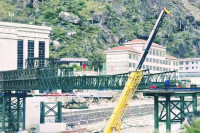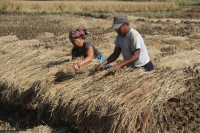Money
Paddy output drops due to land plotting
Fertile farmlands in the eastern district of Jhapa, which is also known as the country’s grain basket, are being rapidly buried under concrete, and the effects of the land plotting are becoming visible in food production.
Parbat Portel
Fertile farmlands in the eastern district of Jhapa, which is also known as the country’s grain basket, are being rapidly buried under concrete, and the effects of the land plotting are becoming visible in food production.
According to locals, unnecessary construction of roads in the name of development has prompted land plotting for housing estates. “The hidden motive behind the construction of roads is plotting,” said Megh Raj Khanal, a farmer at Bahundangi, Jhapa.
According to the District Agriculture Development Office, 4,000 hectares out of the total 159,920 hectares of cultivable land have been turned into concrete. Nearly, 2,000 hectares of land remain uncultivated.
When a bigha of land is developed for housing, it directly affects 15 to 20 bighas of surrounding land. “The area of land suitable for growing crops has been decreasing annually due to plotting which has also led to a fall in food grain production,” said Shaligram Bhattarai, technical assistant at the office.
Jhapa district, which once used to export paddy and rice to Indian border markets, has now become a large importer of food. According to the Mechi Customs Office, paddy and rice imports are swelling annually. In the last fiscal year, Jhapa imported paddy worth Rs30 million. Paddy imports have reached Rs25 million in the first 10 months of the current fiscal year.
Imports of broken rice are also increasing. Rs25 million worth of broken rice, which is mainly used in making alcohol, had been imported as of the first 10 months of this fiscal year.
According to Om Prakash Sarawogi, provincial parliamentarian and trader, around 22 rice mills used to produce steamed rice and export it to India in the past decades. The main markets were West Bengal, Bihar and southern part of India. Now, Nepal has started importing rice.
Traders said that due to the high prices of paddy produced in Nepal, they are forced to import fine rice from India.
Surya Agro Mill of Mechinagar, Jhapa purchased Ranjit Mansuli paddy at the rate of Rs4,000 per quintal last year. However, the mill is not getting paddy by paying Rs5,500 this year. “The
price has increased by Rs1,500 within a year,” said Sanjay Kumar Minda, manager of Surya Agro. The fine variety of paddy is not available although traders are willing to pay high prices for it, he added.
Rice mills have hiked the price of paddy by Rs5 per kg. “Even then, we cannot get enough paddy of such fine variety in the district, and we are compelled to import it from India,” he said.
According to traders, the price of Ranjit paddy is Rs5,500 per quintal. Similarly, paddy such as Sona Mansuli is being sold at Rs4,700, Jira Masino at Rs6,250 and Basmati at Rs11,100 per quintal. Most of the mills import paddy from India which is processed into rice and packaged and sold in Nepal.




 18.12°C Kathmandu
18.12°C Kathmandu















